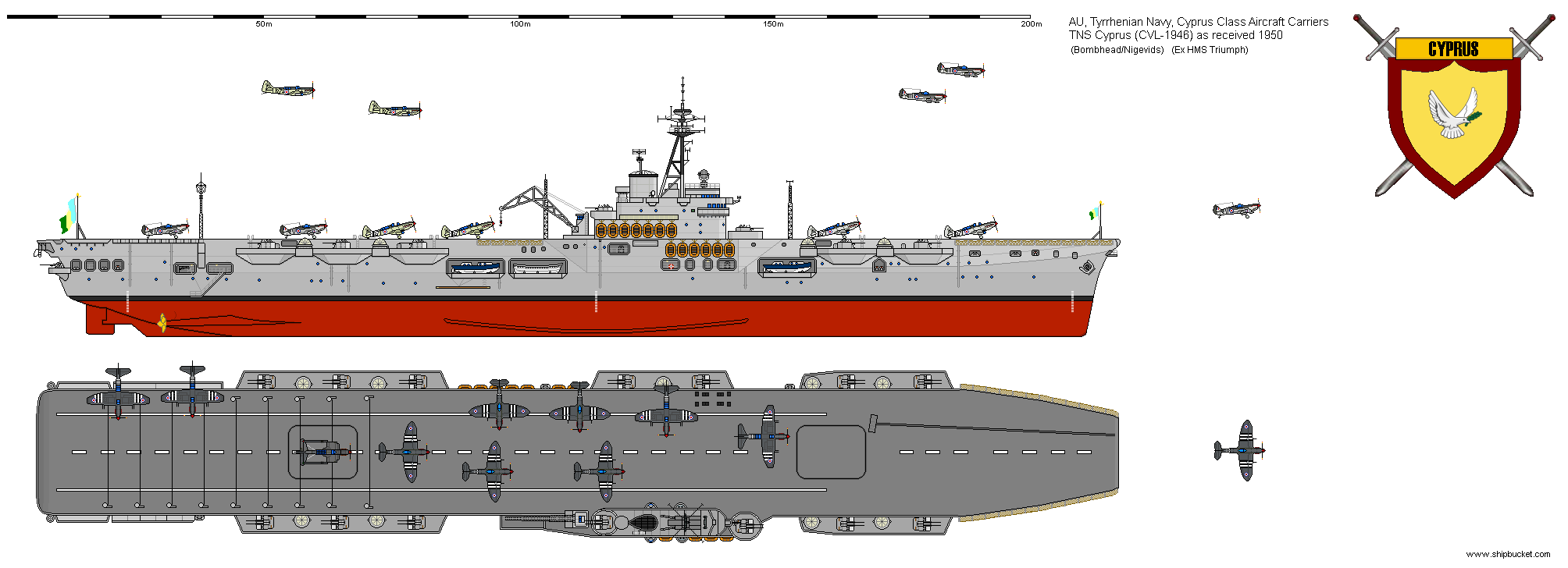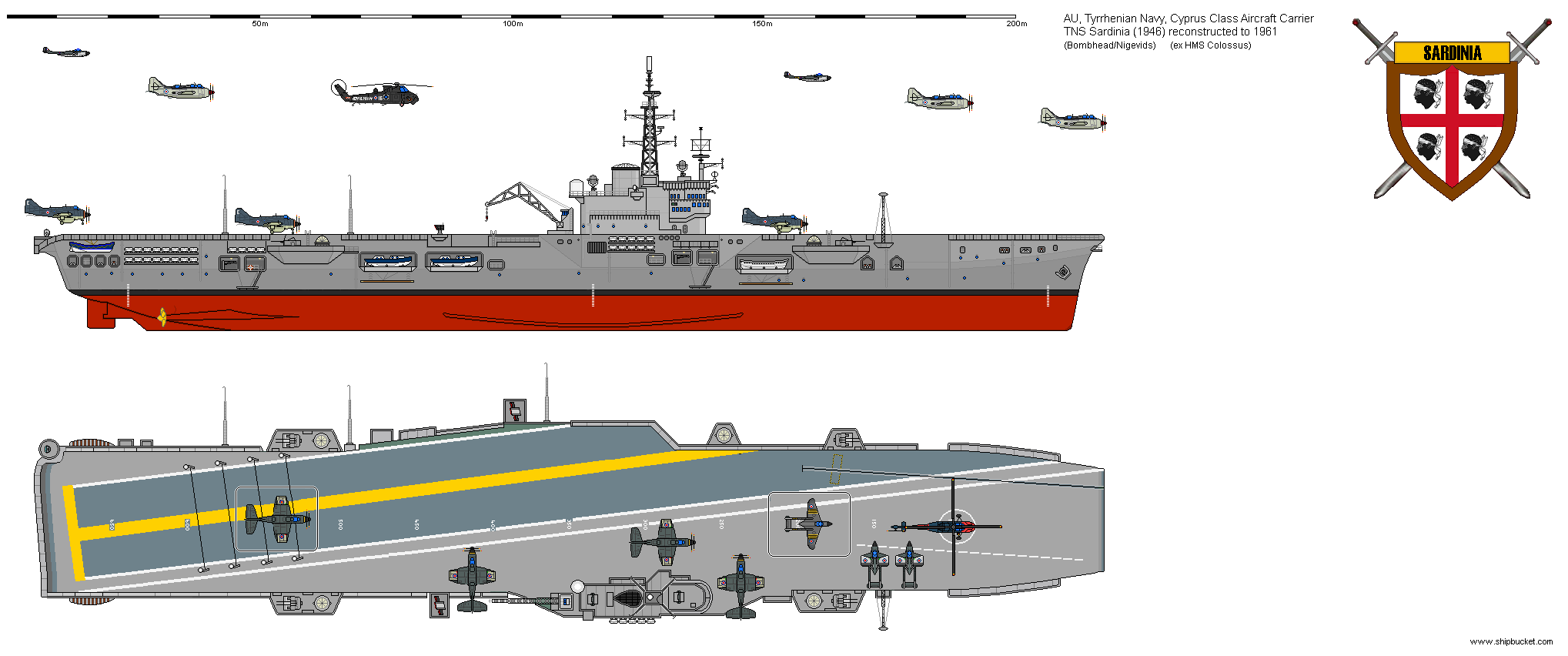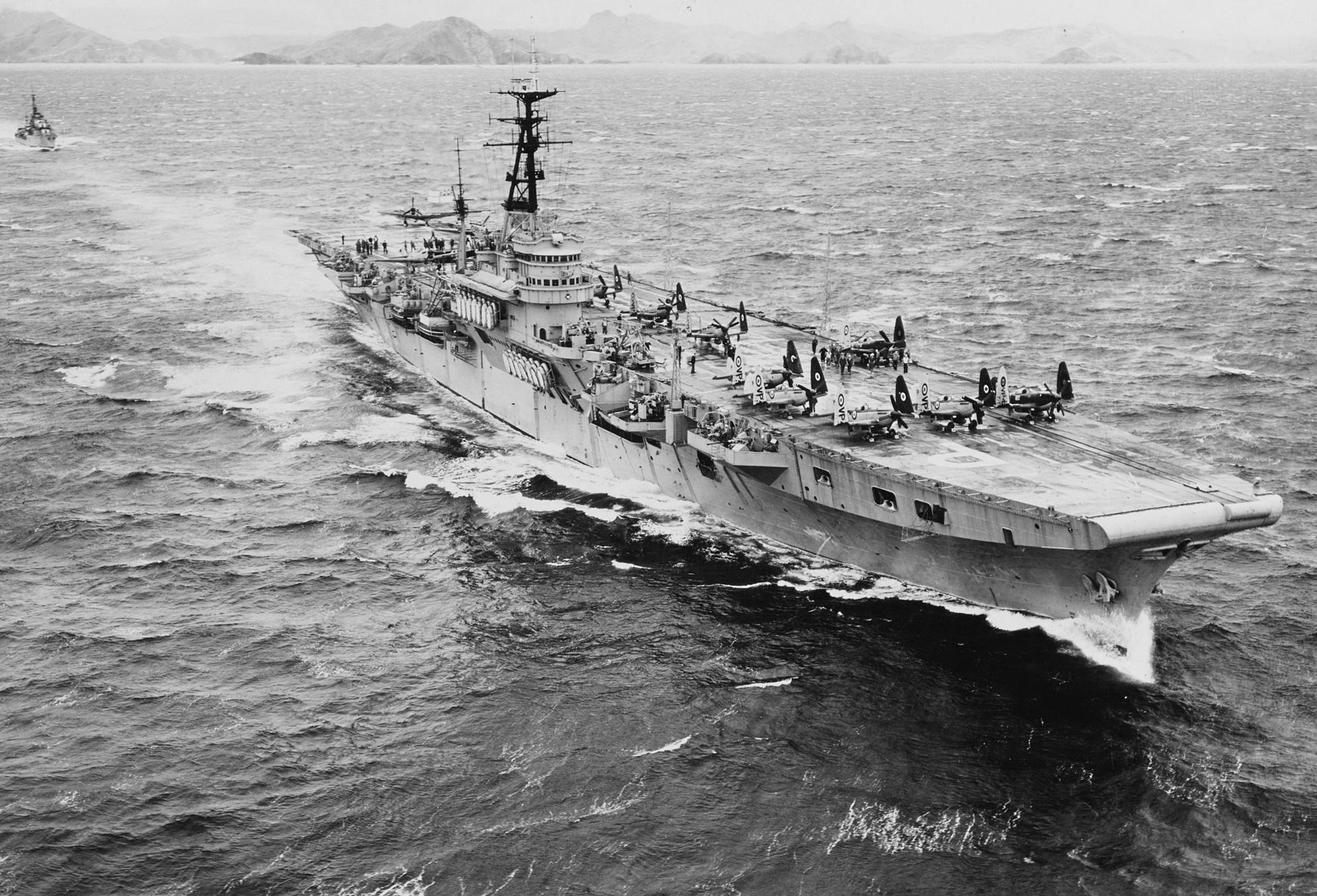Cyprus Class
Aircraft Carriers.
Return to
Tyrrhenian Navy page:
The Tyrrhenian Admiralty had scrapped the part built liner conversion as part of
the reparation deal. But the Admiralty still wanted to have aircraft carriers
after what had happened to their forces during World War 2. The Royal Navy
had almost twenty light fleet carriers either completed or in final fitting out
at the end of WW2. The six Colossus class were all completed for the UK between
1950-58. With the Colossus class completing the Royal Navy was to divest itself
of six of the older Majestic Class. Tyrrhenia put its name down for two of the
Majestic class carriers receiving the first in 1950 and the second in 1952. The
names allocated to those ships followed the normal convention of keeping the
islands of Tyrrhenia involved by naming new Capital Ships after them. The
previous Cyprus had gone to France and the Sardinia had been sunk during WW2.
HMS Triumph arrived in Tyrrhenian waters in 1950 and went through its acceptance
trials. the ship being christened into the Tyrrhenian navy as Tyrrhenian Navy
Ship Cyprus.

Both ships arrived in their original Royal Navy states and any alterations to be
done to the ships would have to be carried out by the Tyrrhenian dockyards. As
all the new improvements came along the Tyrrhenian Navy received plans for the
upgrading of their ships (angled flight deck etc) or had to purchase the
technology from either Britain or the United States (mirror landing sights etc).
The Cyprus having been first into service got the updates first, but it also
meant that the Sardinia got the updates after they had been proved.
| Displacement |
13,850 tons standard, 18,400 tons full load |
| Length |
695 ft |
| Breadth |
80 ft |
| Draught |
22 ft |
| Machinery |
2shaft Steam turbines,
40,000shp |
| Speed |
25 knots as completed |
| Range |
12,000 miles at 14 knots |
| Armour |
splinter protection around machinery and
armouries |
| Armament |
As Completed 1946
30 x 40mm (14x2, 2x1)
|
| Aircraft |
34-36 depending on size and type. (52
with deck park) |
| Complement |
1060 (1110 as Flagship) |
| Notes |
TNS Cyprus (1950) retired 1990, scrapped
1992
TNS Sardinia (1952) retired 1995, scrapped 1997 |
The Cyprus had two squadrons of Seafires and two squadrons of Fireflies when it
started its Tyrrhenian service. After two months there were only six Seafires
left, the rest had been lost in landing accidents. Those six Seafires were
landed and became part of the Air Force. The Cyprus operated with the two
squadrons of Fireflies till it received new Sea Vampire aircraft. 1952 and the
new TNS Sardinia sailed into Syracuse harbour to rapturous applause as besides
the ship, it was filled with aircraft. Five squadrons of Vampires and another
two squadrons of Fireflies had been squeezed aboard, both in the hangar and on
the flight deck as deck park.
One squadron of Vampires went to the Air Force while the other four squadrons
were for the carriers. The two ships were only able to operate 34-36 aircraft at
a time. Each carrier had two full squadrons and two half squadrons each of
Vampires and Fireflies. The rest were kept at the Syracuse Naval Air base and
were used for protection of the base, but mainly as trainers and replacement
aircraft for the carriers.

The Vampires were upgraded to Venoms from 1960 and the Gannet was added to
provide an ASW force for the first time. This was to be aided by the addition of
helicopters from the mid 1960's. The final upgrades for the aircraft was the
introduction of the Skyhawk fighter bombers from the early 1970's along with the
Tracker series of aircraft. Thought was given to giving the ships ski jumps to
operate Sea Harriers, but the cost was to prohibitive for such old ships. When
the ships were removed from service, their air complements were transferred to
the air force.
Both ships received their angled decks, Cyprus 1958-60 then Sardinia 1960-61.
The angled deck improved the types of aircraft that could be carried, but
reduced the amount that could be carried.
The two ships operated with the combined Mediterranean fleet which included the
Italian carriers and American Sixth Fleet keeping the Russian Navy under
surveillance.
| Displacement |
16,000 tons standard, 19,100 tons full load |
| Length |
700 ft |
| Breadth |
128 ft |
| Draught |
24 ft |
| Machinery |
2 shaft Steam turbines,
40,000shp |
| Speed |
24 knots after reconstruction to angled
decks |
| Range |
12000 miles at 14 knots / 6,200 at 23
knots |
| Armour |
12-8in belt, 6in decks,
14"/9"/6" turrets |
| Armament |
After angled flight deck fitting.
8 x 40mm (4x2)
two of the twin 40mm were replaced with Sea Cat units. |
| Aircraft |
28 depending on size and type |
| Complement |
1100 (1180 as Flagship) |
| Notes |
TNS Cyprus (1950) retired 1990, scrapped
1992
TNS Sardinia (1952) retired 1995, scrapped 1997 |

Vampires operating off TNS Cyprus in the mid-50's
General characteristics (Vampire)
-
Crew: 1
-
Length: 30 ft 9 in (9.37 m)
-
Wingspan: 38 ft (11.58 m)
-
Height: 8 ft 10 in (2.69 m)
-
Wing area: 262 ft² (24.34 m²)
-
Empty weight: 7,283 lb (3,304 kg)
-
Max. takeoff weight: 12,390 lb (5,620 kg)
-
Powerplant: 1 × de Havilland Goblin 3 centrifugal turbojet, 3,350 lbf
(14.90 kN)
Performance
-
Maximum speed: 548 mph (882 km/h)
-
Range: 1,220 mi (1,960 km)
-
Service ceiling: 42,800 ft (13,045 m)
-
Rate of climb: 4,800 ft/min (24.4 m/s)
Armament
-
Guns: 4 × 20 mm (0.79 in) Hispano
Mk.V cannon with 600 rounds total (150 rounds per gun).
-
Rockets: 8 × 3-inch "60 lb" rockets
-
Bombs: 2 × 500 lb (225 kg) bombs or two drop-tanks

General characteristics (Gannet)
-
Crew: 3
-
Length: 43ft (13m)
-
Wingspan: 54ft 4in (16.56m)
-
Height: 13ft 9in (4.19m)
-
Wing area: 483 ft² (45 m²)
-
Empty weight: 15,069 lb (6,835kg)
-
Powerplant: 1 ×
Armstrong Siddeley Double Mamba ASMD 1
turboprop, 2,950 hp (2,200kW)
-
Propellers: 2 contra-rotating 4-bladed
Performance
-
Maximum speed: 310 mph (500 km/h)
-
Endurance: 5-6 hours
-
Service ceiling: 25,000 ft (7,600 m)
Armament
- Up to 2,000 lb of bombs, torpedoes, depth
charges and rockets
Avionics

HMS Triumph in the Med, on its way to become the TNS Cyprus. Note Seafires and
Fireflies on deck.
Return to
Tyrrhennian Navy page:




